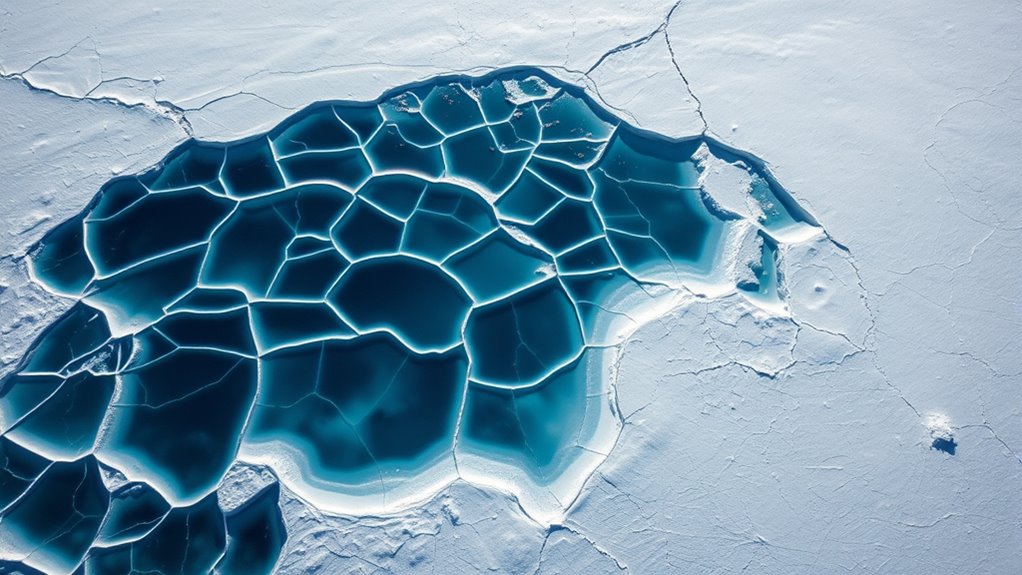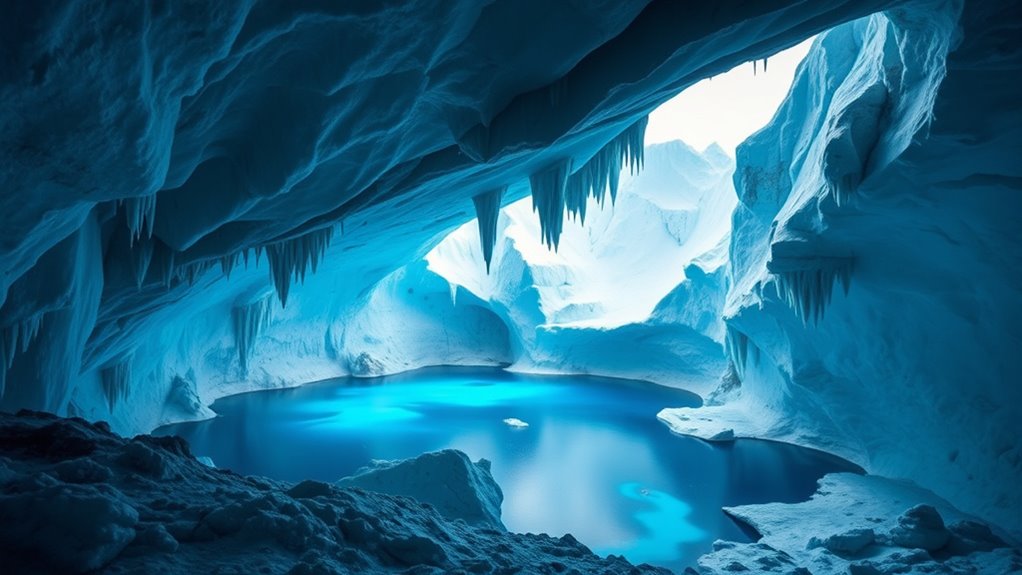Subglacial lakes beneath Antarctica’s ice sheets reveal how climate change impacts our planet’s cryosphere. Using radar and satellite technology, scientists map these hidden water bodies to understand how melting surface ice enlarges and connects lakes, affecting ice flow and stability. This process can lead to rapid ice sheet movement and sea-level rise. Exploring these discoveries shows how climate change influences the delicate balance of Antarctica’s environment, and if you continue, you’ll uncover even more fascinating details.
Key Takeaways
- Subglacial mapping uncovers hidden lakes that influence ice sheet stability and movement amid climate change.
- Increased surface melting causes expansion and connectivity of subglacial lakes, altering pressure systems.
- Water from these lakes lubricates ice flow, potentially accelerating ice mass loss and sea-level rise.
- Monitoring subglacial lakes helps predict rapid ice dynamics and potential outburst events.
- Understanding the hidden water systems aids in refining climate models and future sea-level projections.

Have you ever wondered what secrets lie beneath Antarctica’s icy surface? Beneath the vast ice sheets, hidden lakes sit quietly, concealed by thousands of feet of ice. These subglacial lakes are more than just curious features; they’re key to understanding the continent’s cryosphere dynamics and how climate change impacts this fragile environment. Modern subglacial mapping techniques have uncovered these submerged worlds, revealing a complex network of water systems that influence ice flow and stability. By studying subglacial hydrology—the movement of water beneath the ice—you gain insights into how meltwater channels and lakes interact with the ice sheet, affecting its behavior over time.
Hidden lakes beneath Antarctica’s ice reveal crucial insights into cryosphere dynamics and climate change effects.
When scientists map the subglacial landscape, they’re essentially peering into a hidden universe that shapes Antarctica’s cryosphere. The presence of lakes beneath the ice plays a critical role in cryosphere dynamics; they act as buffers, lubricating the ice sheet’s movement and potentially accelerating ice mass loss. As climate change leads to increased surface melting, more water seeps down through cracks and crevasses, enlarging and connecting these lakes. This process can alter the pressure and flow within the subglacial hydrological system, causing the ice to slide more rapidly toward the coast. Subglacial hydrology, thus, becomes a fundamental factor in predicting future ice sheet stability and sea-level rise. Additionally, subglacial water systems are dynamic, responding quickly to environmental changes and influencing the overall stability of the ice sheet. A better understanding of subglacial water movement can help improve predictive models of ice sheet behavior. Researchers are also developing new mapping technologies to better visualize these hidden water bodies beneath thick ice sheets.
Using radar and satellite technology, scientists have pinpointed the locations and depths of these lakes, mapping their extent across Antarctica. This ongoing research helps us understand how these hidden water bodies respond to changing surface temperatures and atmospheric conditions. When meltwater accumulates in subglacial lakes, it can trigger sudden outbursts, releasing large volumes of water that influence ice dynamics. These events, in turn, can reshape the cryosphere by altering ice flow patterns and contributing to more rapid ice loss. Advances in subglacial mapping techniques continue to enhance our understanding of these processes, providing critical data for climate models.
Understanding subglacial hydrology is indispensable for grasping the bigger picture of climate change impacts. The more we learn about how water moves beneath the ice, the better we can predict how Antarctica’s ice sheet will respond to a warming climate. Each discovery of a hidden lake or new mapping of subglacial features brings us closer to understanding the delicate balance of Antarctica’s cryosphere. It’s a reminder that beneath the icy surface lies a dynamic, interconnected system—one that’s susceptible to change but also holds clues to the future of our planet’s climate.
Frequently Asked Questions
How Do Scientists Access Subglacial Lakes Without Drilling Through Ice?
You might wonder how scientists access subglacial lakes without drilling through ice. They use remote sensing techniques like ice-penetrating radar to detect hidden water bodies beneath the ice sheet. This powerful technology sends radio waves through the ice, reflecting off the lake’s surface. By analyzing these reflections, scientists can map and study the lakes remotely, avoiding the need for invasive drilling and gaining insights into climate change impacts.
What Unique Ecosystems Might Exist in Antarctica’S Hidden Lakes?
You might wonder what unique ecosystems exist in Antarctica’s hidden lakes. These extreme environments host diverse microbial life, including extremophiles that thrive under high pressure, low temperatures, and darkness. You could find microbial diversity that’s unlike anything on the surface, revealing habitats adapted to harsh conditions. Studying these ecosystems helps you understand how life persists in extreme environments and offers clues to possible extraterrestrial life in similar icy worlds.
Can Subglacial Lakes Influence Global Sea Levels?
You might wonder if subglacial lakes impact global sea levels. They do, because they influence ice sheet dynamics; when these lakes drain or change, they can accelerate ice flow into the ocean. This process may contribute to rising global sea levels over time. By studying these lakes, scientists can better understand how ice behaves under climate change and predict future sea level shifts.
How Do Changes in These Lakes Affect Antarctic Ice Stability?
You might wonder how changes in subglacial lakes affect Antarctic ice stability. When ice melt increases, it alters lake dynamics beneath the ice sheet, weakening ice shelves and increasing the risk of ice flow acceleration. These fluctuations can destabilize the ice sheet, contributing to sea level rise. Monitoring lake changes helps predict future ice behavior, emphasizing the importance of understanding how lake dynamics influence Antarctica’s overall ice stability.
Are There Any Potential Biological Hazards From Exploring These Lakes?
When exploring Antarctica’s hidden lakes, you should be aware of potential biodiversity risks and microbial threats. These pristine environments may harbor unknown microorganisms that could pose biological hazards if released or contaminated. You might unknowingly introduce invasive species or disrupt fragile ecosystems. To protect both your team and the lakes’ unique biodiversity, strict biosecurity protocols are essential, preventing the spread of harmful microbes and minimizing ecological risks during exploration.
Conclusion
Now that you’ve uncovered Antarctica’s hidden lakes, you realize they’re like secret time machines, holding clues to our planet’s future. Mapping these subglacial treasures could unlock the biggest climate secrets ever, possibly saving humanity from disaster or unleash unpredictable chaos. So, next time you think glaciers are just icy giants, remember—they’re hiding underwater worlds that could rewrite everything you thought you knew about climate change. The stakes have never been higher!
Amina brings over a decade of journalism experience to her role as Editor-in-Chief. Under her leadership, Exquisite Post has flourished, maintaining the highest standards of integrity and excellence. Amina’s commitment to truth and her visionary approach guide the editorial team in producing impactful news stories that resonate with our audience.










